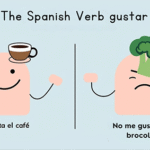Ser & Estar (To Be) in Spanish
Mastering ser and estar is one of the biggest challenges for Spanish learners. Both verbs mean “to be”, but they are used in completely different ways.
There are two equivalents of the verb “to be” in Spanish: Ser and Estar. They are used to indicate the fallowing in Spanish:
| ser | estar |
| posession | current condition |
| nationality | location |
| origin | |
| marital status | |
| material that things are made out of | |
| main characteristics | |
| expression of time and date | |
| profession |
Ser in the present simple tense
| pronoun | verb | translation |
| yo | soy | I am |
| tú | eres | you are |
| él, ella – usted | es | he, she, it is – you are (formal) |
| nosotros | somos | we are |
| vosotros | sois | you are (plural) |
| ellos, ellas – ustedes | son | they are – you are (formal plural) |
Examples
| Yo soy americano | I am American | |
| Tú eres mi amigo | You are my friend | |
| El es ingles | He is English | |
| Nosotros somos estudiantes | We are students | |
| Vosotros sois de California | You are (plural) from California | |
| Ellos son delgados | They are thin |
Estar in the present simple tense
| pronoun | verb | translation |
| yo | estoy | I am |
| tú | estás | you are |
| él, ella – usted | está | he, she, it is – you are (formal) |
| nosotros | estamos | we are |
| vosotros | estáis | you are (plural) |
| ellos, ellas – ustedes | están | they are – you are (formal plural) |
Examples
| Yo estoy cansada | I am tired | |
| Tú estás listo | You are ready | |
| Ella está cerca | She is near | |
| Nosotros estamos aquí | We are here | |
| Vosotros estáis enfermos | You are (plural) sick | |
| Ellos están hablando | They are speaking |
1. When to Use SER (Permanent Traits)
SER is used for permanent, inherent, or defining characteristics. Remember the acronym DOCTOR:
D – Description
- Él es alto. (He is tall.)
- Somos estudiantes. (We are students.)
O – Occupation
- Ella es doctora. (She is a doctor.)
- ¿Eres profesor? (Are you a teacher?)
C – Characteristics
- El libro es interesante. (The book is interesting.)
- Ellos son amables. (They are kind.)
T – Time & Dates
- Hoy es lunes. (Today is Monday.)
- Son las tres. (It’s three o’clock.)
O – Origin
- Soy de México. (I am from Mexico.)
- El vino es de España. (The wine is from Spain.)
R – Relationships
- Ella es mi madre. (She is my mother.)
- Ellos son amigos. (They are friends.)
2. When to Use ESTAR (Temporary States)
ESTAR is for temporary conditions, locations, and emotions. Remember PLACE:
P – Position
- El libro está en la mesa. (The book is on the table.)
- Estoy sentado. (I am seated.)
L – Location
- Madrid está en España. (Madrid is in Spain.)
- ¿Dónde estás? (Where are you?)
A – Action (Progressive Tenses)
- Estoy comiendo. (I am eating.)
- Estábamos hablando. (We were talking.)
C – Condition
- Estoy cansado. (I am tired.)
- La ventana está rota. (The window is broken.)
E – Emotion
- Estoy feliz. (I am happy.)
- Ella está enojada. (She is angry.)
3. Key Differences (With Examples)
| SER (Permanent) | ESTAR (Temporary) |
|---|---|
| Soy mexicano. (I am Mexican.) | Estoy en México. (I am in Mexico.) |
| Es tarde. (It is late.) | Está lloviendo. (It is raining.) |
| La manzana es verde. (The apple is green.) | La manzana está podrida. (The apple is rotten.) |
⚠️ Warning! Some adjectives change meaning with ser vs estar:
- Ser aburrido = To be boring (trait)
- Estar aburrido = To be bored (feeling)
Try the Ser Vs. Estar Quiz:
📝 Ser vs Estar Quiz
Test your knowledge with 20 interactive questions! Get instant feedback and explanations.
🎉 Quiz Complete!
0/20



